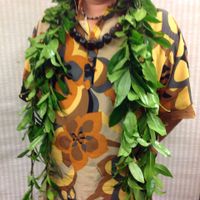
Plants and flowers hold strong cultural significance in Hawaiian culture. Even today, lei are used in the islands for special occasions and cultural ceremonies. The maile lei is a popular choice for its representation of blessings and honor. If you’re new to the islands or want to learn more, this guide will detail the origin and significance of the maile lei.
What to Know About the Maile Lei
What Is Maile?
 The maile vine is native to Hawaii and has deep green, fragrant leaves. When worn as a lei, the leaves are plucked and bound by raffia or sturdy string, draped around the shoulders, and left open-ended. It can also be intertwined with delicate strands of rose buds or tuberose for special occasions. When dried, maile lei can last several years and serve as a token of remembrance.
The maile vine is native to Hawaii and has deep green, fragrant leaves. When worn as a lei, the leaves are plucked and bound by raffia or sturdy string, draped around the shoulders, and left open-ended. It can also be intertwined with delicate strands of rose buds or tuberose for special occasions. When dried, maile lei can last several years and serve as a token of remembrance.
What Is Its Cultural Significance?
Traditionally, the maile vine is connected to Laka, the goddess of hula. Laka was often celebrated with hula dances and maile at her alters and temples. This plant was also offered as a sign of peace between warring chiefs.
How Is It Used in Special Occasions?
Today, maile is most often used as a lei by males. Hula dancers still wear strands of maile, and teenage boys opt for a maile to prom instead of a boutonnière. Maile lei are gifted to celebrate special occasions like graduations, birthdays, and retirements. A kahu, or Hawaiian priest, will perform cultural ceremonies with maile during special occasions like blessings, groundbreakings, and grand openings for local businesses.
Looking for a special lei for a loved one? Pali Florist & Gift Shop has quality plants and flowers for any occasion. Located in Kailua, HI, they’ve been serving the local community for over 30 years and offer a variety of roses, tropical plants, and lavish arrangements. Visit their website to learn more and call (808) 261-1818 to create your own arrangement.
About the Business
Have a question? Ask the experts!
Send your question

